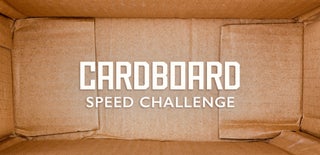Introduction: Make a Cardboard Pinball Machine!
Since quarantine has gotten pretty boring, I wanted to make something that my family and I could play together that aren't video games, so I made this pinball machine. This is a very fun project that takes around 2 hours. This instrucatable does have a lot of steps, but don't let that overwhelm you. I just tried to make it as clear as possible, thus adding a lot of steps but it is still a pretty quick build.
Supplies
Tools:
- A craft knife or box cutter
- Scissors
- A marker or pencil
- A ruler
- A hot glue gun and glue
- Tape
Supplies:
- Lots of cardboard
- Atleast 4 rubber bands
Some sort of round dowel(I just used some disposable chopsticks and old pencils)
Step 1: Cut Main Board
We need to first cut 1 piece of cardboard that will be the main flat table that the ball rolls on for our table. I made mine 10" wide by 18" long, but you could make it bigger if you wanted a bigger table. Next, make 2 marks, each 4" away from the bottom and 2" from the edge on 1 side and 3" away from the edge on the other side. After this, poke these marks out with something like a screwdriver to make some holes. They should be a little bit bigger than whatever dowel you are using(in my case a cut-up chopstick).
Step 2: Make Flippers
To make the flippers, cut 10 pieces of cardboard each measuring 1" by 2.5". After this, draw a flipper shape on 1 of them(check the image) and then cut this out. We then need to cut all of them out like this and I found the quickest way of doing this was by using our first flipper as a guide. After you have 10 cardboard pieces in the shape of a flipper, glue 5 of them on top of each other to make a flipper. Do this another time to make the other flipper. After this, poke a hole it both of them around half an inch away from the back edge(check images). After this, cut 2 pieces of whatever dowel you are using(in my case a chopstick) to around 3" long. Glue 1 end of each inside the hole we just made in the flipper.
Step 3: Start on the Flipper Mechanism
After you have made 2 flippers like shown in the image in the previous step, put them on one side of our main board by inserting the dowels through the holes. Next, cut out another 10 pieces of cardboard each measuring 1" by 2.5". After this stack and glue 5 of them on top of each other like we did in the last step(but they do not need to be in the shape of a flipper) to make the "mechanism arm". After this, poke a hole on each of the mechanism arms(shown in the picture above). After this, attach the mechanism arms to the dowel that is connected to the flipper on the other side(see diagram).
Step 4: Finish the Flipper Mechanism
After you have secured the flipper arm to the flipper mechanism, cut 10 pieces of cardboard 1" by 4". After this, glue 5 of them together to make the pusher rod. Next, fold a strip over this piece of cardboard, like shown in the photo. Glue both ends of this down so the rod can freely slide through it(see photos above). Next, glue a piece of dowel to the other end of the arm and one to the side of the strip you just folded over. Next, connect a rubber band between these 2 dowels to spring load the flipper(see photos).
Step 5: Make Side Panels
After you've finished the flippers, cut out 2 cardboard side panels and glue them to the side of the main table portion. Make sure to cut out holes where the flipper buttons are so you can still use them.
Step 6: Make the Launcher
Next, make the ball launcher by first cutting a 1" by 12" strip of cardboard. Next, make 2 folds, each 5.5" from the edge so you can make a U shape with the cardboard-like show in the image. After this, poke a hole that is a little bit bigger than whatever dowel you are using between the 2 folds and insert a 3" piece of dowel in it. Next, glue a rubber band to each fold on the inside of the "U" shape and then connect these rubber bands to the end of the dowel that is coming out on the other side(see image). Finish this by gluing the U shape of cardboard to one side wall on the pinball table. To finish this, make a back wall to glue on the back of the table so the ball doesn't roll off.
Step 7: Add Obstacles!
Now that we have finished all the mechanisms and moving parts, comes the fun part. You really can add whatever obstacles or decorations you want but I added a few bumpers by wrapping rubber bands around some skewers and a few ramps. I recommend looking at real pinball tables to get some inspiration for the obstacles.
Thanks for reading, have fun!

Participated in the
Cardboard Speed Challenge













